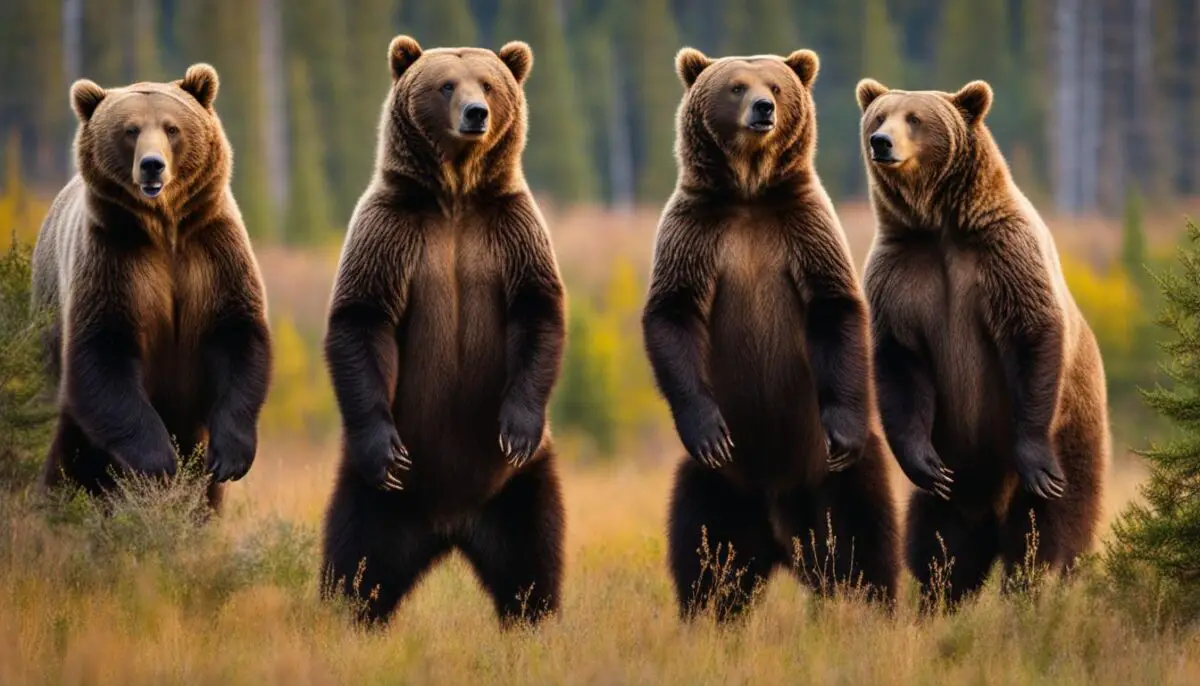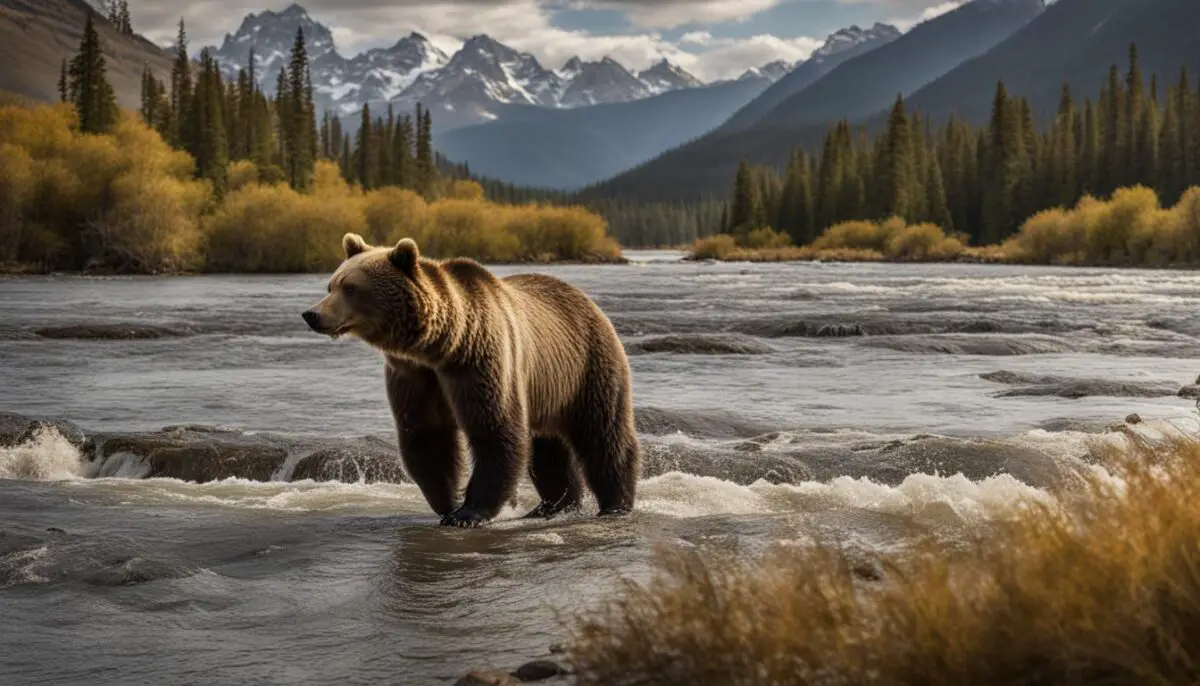Grizzly bears, known for their strength and status as top predators, can reach impressive heights when standing on their hind legs. Male grizzly bears are generally taller than females.
On all fours, the average shoulder height of a grizzly bear is about 102 cm or 3.35 feet. However, when standing on their hind legs, adult male grizzly bears can reach heights of up to 2.44 meters or 8 feet, while larger individuals may measure up to 3 meters or 9.8 feet. The tallest recorded grizzly bear, named Goliath, stood at 12 feet tall.
Key Takeaways:
- Male grizzly bears are generally taller than females.
- When standing on their hind legs, adult male grizzly bears can reach heights of up to 8 feet.
- The tallest recorded grizzly bear stood at 12 feet tall.
- Grizzly bears’ height on hind legs is compared with humans and other bear species to provide perspective on their impressive stature.
- Grizzly bears are remarkable creatures with impressive height capabilities.
Grizzly Bear Size and Appearance
Grizzly bears, a subspecies of brown bears, are native to North America. These magnificent creatures possess an awe-inspiring size and appearance that sets them apart from other bear species.
When standing on all fours, grizzly bears are typically 3 to 5 feet tall at the shoulder, showcasing their substantial stature. But it is when they stand upright on their hind legs that their true height becomes evident. These powerful bears can reach towering heights of almost 9 feet, making them a true spectacle in the animal kingdom.
Male grizzly bears, known as boars, are larger and heavier than their female counterparts, sows. Boars can weigh up to an astounding 860 pounds, while sows weigh up to 455 pounds. It is their sheer size and strength that make them one of the largest land carnivores.
Grizzlies display a striking diversity in coat color, ranging from blond to black, with variations in between. This wide range of colors adds to their allure and makes each individual bear unique. Additionally, grizzlies can be distinguished from black bears by their body shape, distinctively large shoulder hump, dish-shaped faces, and straighter claws.
Intimidating yet fascinating, grizzly bears captivate the imagination with their remarkable size and distinctive features. Let’s explore their height in comparison to other bear subspecies in the next section.

Grizzly Bear Height Comparison
To understand the impressive stature of grizzly bears, it is helpful to compare their height with other bear species and humans. While on all fours, the average shoulder height of a grizzly bear is about 102 cm or 3.35 feet. However, when standing on their hind legs, adult male grizzly bears can reach heights of up to 2.44 meters or 8 feet. Larger individuals may even measure up to 3 meters or 9.8 feet. The tallest recorded grizzly bear, named Goliath, stood at a towering 12 feet tall.
Compared to humans, grizzly bears’ height on hind legs is truly impressive. Standing at 8 feet, they tower over most humans. Their size and strength make them one of the largest land carnivores.
Grizzly Bear Height Facts
Here are some fascinating grizzly bear height facts:
- Grizzly bears are taller when standing on their hind legs than when on all fours.
- Adult male grizzly bears can reach heights of up to 8 feet or more.
- Grizzlies have powerful muscles in their hump, which contributes to their height and strength.
- They are slightly smaller than the Alaskan Kodiak bear, the largest brown bear subspecies.
“The grizzled bear on hind legs looks like a colossal creature, towering over its surroundings with an awe-inspiring presence.” – Wildlife enthusiast
Grizzly bears’ impressive height and physical characteristics make them a truly remarkable species in the animal kingdom.
Grizzly Bear Reproduction and Life Cycle
During the mating season, which occurs from May to July, grizzly bears engage in the fascinating process of reproduction. Female grizzlies exhibit a unique reproductive adaptation called delayed implantation. After mating, fertilized eggs remain dormant in the female’s uterus until she goes into hibernation in the fall.
After a gestation period of 6 to 8 weeks, a female grizzly gives birth to one to four tiny cubs, usually in January or February. At birth, the cubs weigh between 12 and 24 ounces and are incredibly vulnerable. To protect and nurture her offspring, the mother keeps them in a den until they reach about 20 pounds.

Mother grizzlies invest a significant amount of time and effort into raising their cubs, as the bond between them is strong. Cubs typically stay with their mother for about four years before venturing out on their own.
During these years, the mother grizzly teaches her cubs essential survival skills, including hunting, foraging, and navigating their habitat. This period of maternal care is critical for the young grizzlies’ development and prepares them for an independent life.
Understanding the reproductive cycle and life cycle of grizzly bears provides valuable insights into their population dynamics and the challenges they face in maintaining stable populations. It highlights the crucial role of maternal care in ensuring the survival and success of the species.
Key Observations:
- Grizzly bears mate from May to July.
- Delayed implantation enables fertilized eggs to remain dormant until the female enters hibernation.
- A female grizzly gives birth to one to four cubs, typically in January or February.
- Newborn cubs weigh between 12 and 24 ounces.
- The mother keeps the cubs in a den until they reach about 20 pounds.
- Cubs stay with their mother for approximately four years before becoming independent.
By studying grizzly bear reproduction and the intricacies of their life cycle, researchers and conservationists gain important insights that contribute to the continued conservation efforts for these magnificent creatures.
| Grizzly Bear Reproduction and Life Cycle | |
|---|---|
| Key Elements | Details |
| Mating Season | May to July |
| Gestation Period | 6 to 8 weeks |
| Number of Cubs | 1 to 4 |
| Birth Weight of Cubs | 12 to 24 ounces |
| Cub Maturation | About 4 years with mother |
Grizzly Bear Habitat and Diet
Grizzly bears are highly adaptable creatures that can thrive in a variety of habitats across their range. From coastal areas to mixed-conifer forests, grasslands to mountainous forests, and even the harsh environments of the Arctic tundra, these bears have managed to establish their presence.
Grizzlies have home ranges that can cover several square miles, and their territories may overlap with those of other bears. This allows them to navigate their extensive habitats in search of food, mates, and suitable den sites.
When it comes to diet, grizzly bears are omnivores, meaning they consume both plant matter and animal prey. Their diet is incredibly versatile, making them highly adaptable to different food sources found in their habitats.
Grizzlies are known to feast on a variety of fruits, berries, nuts, and roots, taking advantage of what the flora in their environment has to offer. They are particularly fond of foods rich in carbohydrates, which provide them with the energy they need to sustain their large bodies.
However, grizzly bears are also opportunistic hunters, taking advantage of various protein sources to meet their nutritional needs. They have been known to catch and consume fish, especially salmon, as well as prey on larger animals such as elk and moose.
In preparation for hibernation, grizzly bears engage in a feeding frenzy during the summer and fall months. They consume vast quantities of food, building up their fat reserves to sustain them throughout the winter months when food is scarce.
Grizzly Bear Diet
| Plant-Based Foods | Animal-Based Foods |
|---|---|
|
|
Grizzly bears’ diverse diet ensures that they can adapt to the seasonal availability of food in their habitats. By consuming a combination of plant-based and animal-based foods, they are able to maintain their strength and survive in their challenging environments.
Conclusion
Grizzly bears are truly extraordinary creatures, known for their impressive height capabilities. When standing on their hind legs, adult male grizzlies can reach heights of up to 8 feet, showcasing their sheer power and grandeur. The average shoulder height of a grizzly bear on all fours is approximately 3.35 feet, giving us a sense of their imposing stature.
As one of the largest land carnivores, grizzly bears command attention and respect. Their size and strength are unparalleled, making them a force to be reckoned with in the animal kingdom. Understanding the height and measurements of these magnificent creatures provides valuable insights into their remarkable characteristics.
Grizzly bears thrive in a diverse range of environments, from coastal areas to mountainous forests, adapting to their surroundings with ease. Their diet is equally diverse, consisting of plant matter like fruits, berries, and nuts, as well as animal prey such as salmon, elk, and moose.
From their towering height to their versatile habitats and varied diet, grizzly bears embody the epitome of natural strength and adaptability. These awe-inspiring creatures leave an indelible mark on our planet, reminding us of the incredible biodiversity that exists in the world around us.
FAQ
How tall can a grizzly bear be when standing on its hind legs?
Grizzly bears can reach heights of up to 8 feet when standing on their hind legs, with some exceptional individuals measuring even taller.
What is the average shoulder height of a grizzly bear?
The average shoulder height of a grizzly bear on all fours is approximately 3.35 feet.
How does the size of a grizzly bear compare to other bear species?
Grizzly bears are part of the brown bear species and are slightly smaller than the Alaskan Kodiak bear, which is the largest brown bear subspecies.
When do female grizzly bears give birth to their cubs?
Female grizzly bears typically give birth to one to four cubs in January or February, after a gestation period of 6 to 8 weeks.
How long do grizzly bear cubs stay with their mother?
Grizzly bear cubs typically stay with their mother for about four years before venturing out on their own.
What habitats do grizzly bears inhabit?
Grizzly bears can be found in coastal areas, mixed-conifer forests, grasslands, mountainous forests, and Arctic tundra.
What do grizzly bears eat?
Grizzly bears have a versatile diet that includes fruits, berries, nuts, roots, vegetation, and various protein sources such as salmon, elk, and moose.
What makes grizzly bears one of the largest land carnivores?
Grizzly bears’ size and strength contribute to their reputation as one of the largest land carnivores. The hump on their back consists of powerful muscles that give them the strongest front limbs of any animal.
How does understanding grizzly bear height contribute to our knowledge of these animals?
Understanding the impressive height and characteristics of grizzly bears provides valuable insight into their majestic presence in the animal kingdom.


